Somehow I feel this article is relevant and connected to PhillyRising & to the Mural Arts Program. If it is not then it should be.
Early to Dinner:
November 21, 2011
“Greening Vacant Lots Linked to Reduced Gun Violence”
by EMILY BADGER
“Greening Vacant Lots Linked to Reduced Gun Violence”
by EMILY BADGER
“We all know about modern theories of policing that suggests signs of deterioration in a community – vacant lots, boarded-up buildings and, most famously, broken windows – communicate to would-be criminals, “No one cares about this place, so you don’t have to either.” A related theory suggests that the presence of all these same “physical incivilities”promotes weak social ties among residents, increasing crime and discouraging the kind of community self-policing that Jane Jacobs celebrated.
These theories seem sensible. You’re more likely to drop a candy wrapper on a sidewalk that’s already covered in trash. But there hasn’t been a lot of quality, hard data to back this up.
A new study, published online this week in the American Journal of Epidemiology, offers some of the more promising evidence.
Researchers at the University of Pennsylvania studied a 10-year project in Philadelphia to convert vacant lots into park space. They found that gun-related assaults significantly declined in areas around the lots that had been greened. Vandalism and criminal mischief also significantly fell off. …more at link:http://www.theatlanticcities.com/neighborhoods/2011/11/greening-vacant-lots-linked-reduced-gun-violence/526/
Philadelphia Inquirer is Late for Dinner: ” ‘Greening’ Vacant Lots Linked to dip in crime” was published on the front page of Philadelphia Inquirer, November 25, 2011. However the article was not found on the Internet under that title; but it t was found as: University of Pennsylvania study links vacant-lot cleanups, reduced gun crime
Posted: Fri, Nov. 25, 2011, 3:01 AM
By Tom Avril, Inquirer Staff Writer
By Tom Avril, Inquirer Staff Writer
“By clearing trash and planting grass in thousands of vacant lots in Philadelphia, work crews did much more than beautify the landscape.
They also struck a big blow against crime, according to first-of-its-kind research from University of Pennsylvania scientists.
In the areas immediately surrounding 4,436 lots that were “greened” by the Pennsylvania Horticultural Society, there was a net reduction in assaults, gun assaults, and gun robberies compared with areas around lots that were not greened.
The reason? Part of it may be that once a vacant lot is cleared and planted, it is no longer a good hiding place for a gun, the researchers reported online last week in the American Journal of Epidemiology.
“You remove the abandoned automobiles, all the abandoned trash where you can hide firearms,” said lead author Charles Branas, an associate professor of epidemiology at Penn’s Perelman School of Medicine. “All of a sudden, it makes it more challenging for illegal guns to move around the neighborhood.”
The authors said the decrease in crime might also be partly explained by the “broken-windows” theory, which proposes that boarded-up windows, vandalism, and other signs of decay can serve as a magnet for serious crime, because they suggest that no one is in control.
Told of the study findings, Police Commissioner Charles H. Ramsey said both explanations made sense – the elimination of hiding places for guns, and the broader perception that an environment is safe.
“If you bring something special to a neighborhood, it helps to make people feel a little bit better about where they are and where they live,” Ramsey said, adding that he expects the city’s Mural Arts Program to have a similar impact.
Other studies have linked crime rates with elements of the surrounding environment, including a Penn study on take-out liquor stores. But the new research appeared to be the first to look at the effects of transforming vacant lots.
The greening program, a major effort begun under Mayor John F. Street that has received national attention as a weapon against urban blight, involves trash removal and the planting of grass and a few trees. A low wooden fence is typically erected around the border. … more at link:
J.M.




